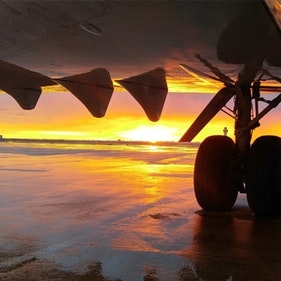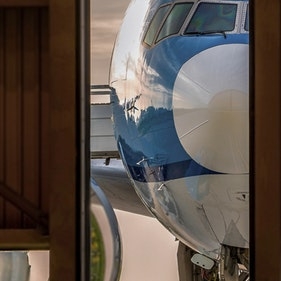As such, our Forecast Update has our latest data and thinking around the COVID-19 pandemic impact on the current and future development of the global commercial aviation fleet and the maintenance, repair, and overhaul aftermarket.
Additionally, our Aviation Market Intelligence team is integrating the fleet groundings, aircraft retirements, new production rates, and other announcements to ensure updated information is available in a supplemental interactive dashboard on this Forecast Update page. The dashboard views include a summary quantification of the updated forecast and the corresponding MRO impact. It is amended weekly as additional changes are announced.
A Challenge For The Aviation Aftermarket
The next decade — 2020 to 2030 — will be more challenging for aviation, even as passenger air travel demand continues to break records. The industry will have to contend with a slower pace of economic expansion, especially in historically high-growth nations such as China. In that nation, economic growth was already slipping even before being rocked by a fast-spreading coronavirus that has infected tens of thousands in just a couple of short months and shut down a large portion of the nation’s industry and business.
Yet, there are other challenges more likely to have longer-term impacts on the industry. As the decade progresses, increased maintenance costs will remain a consideration for airlines as will potential labor shortages in key areas, increased congestion in the air and at airports, and an existential threat that efforts to abate climate change may limit the industry’s growth in the future.
The grounding of the 737 MAX will also have repercussions in the near-term. Originally expected to account for over a quarter of all global aircraft deliveries in 2020 and 2021, the MAX does not look like it will return to service before the summer and will have sizable regulatory hurdles to scale on its way back.
Even with all these challenges, the outlook for the global fleet and aftermarket continues to indicate growth. By the beginning of 2030, the global fleet should swell to over 39,000 aircraft, an average compound growth rate of 3.4 percent annually, driven by continued increases in orders and deliveries. Over the next 10 years, original equipment manufacturers (OEMs) will produce more than 21,000 aircraft, an average of 2,100 annually and more than 30 percent above production for the previous decade.
Global fleet forecast by aircraft class, 2020-2030

Note: CAGR Stands for compound annual growth rate
Source: Oliver Wyman
Half of these deliveries will be replacement aircraft, with aircraft retirements expected to accelerate at a rate of 3.5 percent over the next 10 years. Currently, almost nine percent of the global fleet — close to 2,400 aircraft — is over the age of 25 versus just five percent in 2010.
This aging fleet will have a positive effect on demand for maintenance, repair, and overhaul (MRO) services, particularly in the first half of the decade. In the second half, MRO demand will become increasingly driven by scheduled maintenance on newer aircraft. Along with a larger fleet, increasing utilization rates will push MRO spend to $130 billion in 2030 from $90 billion in 2020, an average annual growth of 3.7 percent.
MRO market forecast by aircraft class, 2020-2030

Note: MRO Stands for maintenance, repair and overhaul; CAGR Stands for compound annual growth rate
Source: Oliver Wyman
While it’s likely to be a rocky decade—especially in the first couple of years—long-term prospects are for reasonable top-line growth. Rising costs and competition may, however, push some parts of the industry to consider consolidation.
Please download the full, 68-page report for a deep dive into the specifics of where, how, and why the fleet and MRO demand will expand during a decade of challenges. Additionally, readers should use our interactive dashboard to explore different cuts on the forecast.
To enhance the 2020-2030 Global Fleet & MRO Market Forecast, our interactive dashboard lets users explore online the results of the forecast in a deeper fashion. To further complement the report, users can look at the size, growth, and share of the global MRO market while also filtering further by aircraft class and within specific MRO segments, users can identify changing trends and the relative size of MRO demand in different market groupings.
An additional view provides more granular insight into the size of the MRO market by year and growth of the market by geographical region. A breakdown of fleet growth in terms of deliveries and retirements is also provided. This view can be filtered by region and MRO segment, allowing users to identify the relative size and growth across specific geographies. For questions or to discuss the broader forecast, please reach out to AviationMarketIntelligence@oliverwyman.com.
About the Forecast
The 2020-2030 edition of our Global Fleet & MRO Market Forecast Commentary represents a two-decade commitment to the understanding and assessment of the commercial airline transport fleet and the associated maintenance, repair, and overhaul (MRO) market outlook. The commentary is the go to resource of aviation executives—whether a manufacturer, operator, or aftermarket provider, as well as for those with financial interests in the sector through private equity firms and investment banks.
This research focuses on airline fleet growth and related trends affecting aftermarket demand, maintenance costs, technology, and labor supply. The outlook reveals significant changes that are important to understand when making business decisions and developing long-term plans.
An interactive tool also accompanies the report for further exploration of the forecast.
Analytical topics in the commentary include:
- In-service fleet, retirements, orders, conversions by aircraft class (widebody, narrowbody, regional jet, and turboprop)
- Global aircraft fleet forecast and regional fleet growth rates including in-service fleet by age
- MRO market forecast by segment (line, component, engine, airframe) and aircraft platform spend
- Economic GDP and traffic data (measured in revenue passenger kilometers or RPKs) by geographic region and specific countries along with utilization cycles
- Passenger and cargo traffic, and airport infrastructure growth in select markets
- Forecast sensitivity analysis based on economic health, traffic, fuel prices, and interest rates













